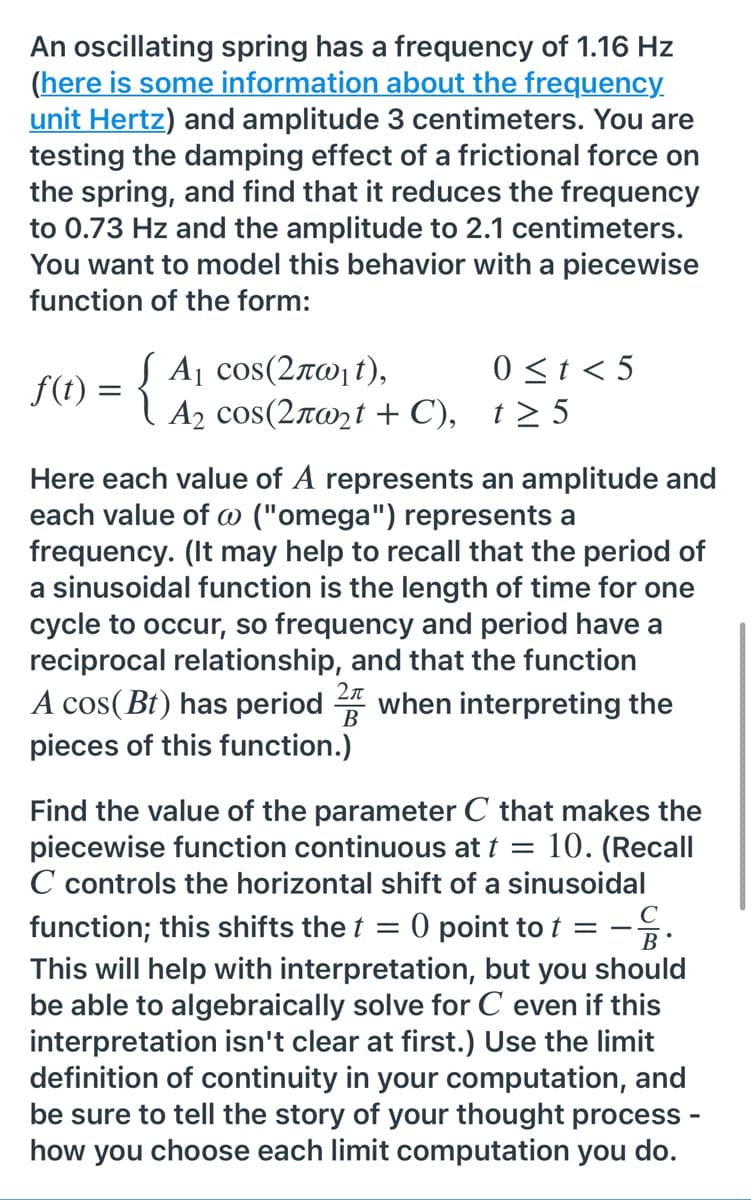An oscillating spring has a frequency of 1.16 Hz (here is some information about the frequency unit Hertz) and amplitude 3 centimeters. You are testing the damping effect of a frictional force on the spring, and find that it reduces the frequency to 0.73 Hz and the amplitude to 2.1 centimeters. You want to model this behavior with a piecewise function of the form: Α Cos(2 πω) 1) , A2 cos(2rort + C), t> 5 0
An oscillating spring has a frequency of 1.16 Hz (here is some information about the frequency unit Hertz) and amplitude 3 centimeters. You are testing the damping effect of a frictional force on the spring, and find that it reduces the frequency to 0.73 Hz and the amplitude to 2.1 centimeters. You want to model this behavior with a piecewise function of the form: Α Cos(2 πω) 1) , A2 cos(2rort + C), t> 5 0
Calculus: Early Transcendentals
8th Edition
ISBN:9781285741550
Author:James Stewart
Publisher:James Stewart
Chapter1: Functions And Models
Section: Chapter Questions
Problem 1RCC: (a) What is a function? What are its domain and range? (b) What is the graph of a function? (c) How...
Related questions
Question

Transcribed Image Text:An oscillating spring has a frequency of 1.16 Hz
(here is some information about the frequency.
unit Hertz) and amplitude 3 centimeters. You are
testing the damping effect of a frictional force on
the spring, and find that it reduces the frequency
to 0.73 Hz and the amplitude to 2.1 centimeters.
You want to model this behavior with a piecewise
function of the form:
0 <t < 5
f(t) = { Aj cos(2x0, t),
A2 cos(2rwzt + C), t> 5
Here each value of A represents an amplitude and
each value of @ ("omega") represents a
frequency. (It may help to recall that the period of
a sinusoidal function is the length of time for one
cycle to occur, so frequency and period have a
reciprocal relationship, and that the function
2л
A cos(Bt) has period 4 when interpreting the
pieces of this function.)
Find the value of the parameter C that makes the
piecewise function continuous at t =
C controls the horizontal shift of a sinusoidal
function; this shifts the t = 0 point to t = -.
10. (Recall
This will help with interpretation, but you should
be able to algebraically solve for C even if this
interpretation isn't clear at first.) Use the limit
definition of continuity in your computation, and
be sure to tell the story of your thought process -
how you choose each limit computation you do.
Expert Solution
This question has been solved!
Explore an expertly crafted, step-by-step solution for a thorough understanding of key concepts.
This is a popular solution!
Trending now
This is a popular solution!
Step by step
Solved in 2 steps with 2 images

Recommended textbooks for you

Calculus: Early Transcendentals
Calculus
ISBN:
9781285741550
Author:
James Stewart
Publisher:
Cengage Learning

Thomas' Calculus (14th Edition)
Calculus
ISBN:
9780134438986
Author:
Joel R. Hass, Christopher E. Heil, Maurice D. Weir
Publisher:
PEARSON

Calculus: Early Transcendentals (3rd Edition)
Calculus
ISBN:
9780134763644
Author:
William L. Briggs, Lyle Cochran, Bernard Gillett, Eric Schulz
Publisher:
PEARSON

Calculus: Early Transcendentals
Calculus
ISBN:
9781285741550
Author:
James Stewart
Publisher:
Cengage Learning

Thomas' Calculus (14th Edition)
Calculus
ISBN:
9780134438986
Author:
Joel R. Hass, Christopher E. Heil, Maurice D. Weir
Publisher:
PEARSON

Calculus: Early Transcendentals (3rd Edition)
Calculus
ISBN:
9780134763644
Author:
William L. Briggs, Lyle Cochran, Bernard Gillett, Eric Schulz
Publisher:
PEARSON

Calculus: Early Transcendentals
Calculus
ISBN:
9781319050740
Author:
Jon Rogawski, Colin Adams, Robert Franzosa
Publisher:
W. H. Freeman


Calculus: Early Transcendental Functions
Calculus
ISBN:
9781337552516
Author:
Ron Larson, Bruce H. Edwards
Publisher:
Cengage Learning